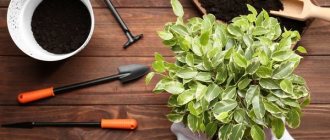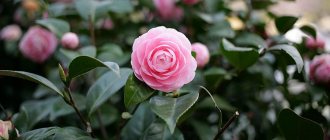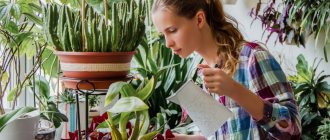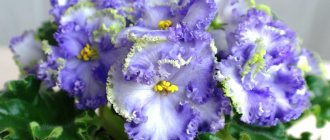It is important to instill in your child a love of nature, including plants, from childhood. And indoor flowers help parents clearly explain to their children about development, care and responsibility. The main thing is to be safe, because some plants have a negative effect on children.
Plants in the Children's Room
Note: For many years, people have grown indoor plants in their homes. Currently, the love for indoor flowers does not fade. Also, many flowers and entire compositions of them can be found in schools, kindergartens, clinics and other institutions.
Why indoor flowers?
Vegetation in a residential building performs several functions at once:
- interior decoration - free-standing flower pots themselves add some freshness to the interior, and well-created compositions make the room more comfortable;
- air filtration (purification) - thanks to the ability of plants to absorb carbon dioxide and release oxygen, the air in the room becomes cleaner. Also, some representatives of the flora are able to purify the air from house dust, which is very important for allergy sufferers;
- disinfection - some types of plants have an antibacterial effect and purify the air from pathogens;
- calming effect - some types of indoor plants have a calming effect;
- medicinal - there are indoor plants (such as aloe, golden mustache, etc.) that have healing properties;
- noise absorption - flower compositions can create special noise insulation in a room. It is especially good to use plants with large large leaves for this;
- distraction - in some cases, indoor flowers can be used to “disguise” defects on the wall, protruding wires, etc.
Children learn to take care of nature
In addition to the above for children, especially older preschool and school age, indoor flowers are needed for education:
- knowledge of the world - study of leaves, shoots, inflorescences, etc.;
- learn to care for plants (plant, water, spray, etc.);
- In the process of caring for plants, the child is instilled with a love of nature and a responsible attitude.
Children and indoor plants
Note: If a family does not have a summer house or a plot of land where the child can be directly “introduced” to nature and caring for plants, then indoor unpretentious flowers in the apartment are an excellent solution.
Watering flowers
The very first exercise that even a one-year-old baby can do is water the flowers.
Immediately teach your child to water as much as required. For this it is good to have a very small watering can. Let the child stand on the step in the bathroom, pour water and water the flowers. Place a sponge or cloth next to the watering can to wipe up spills.
Indoor flowers for children's rooms
If you properly organize a green corner in a children's room, it will help enliven the room and make it more comfortable.
Children's room with indoor flowers
When choosing colors for a children's room, you need to pay attention to the following:
- required care - each type of flower requires certain care (some plants are very capricious);
- which side of the world the windows of the room face - if the windows face the south or west, then light-loving plants are suitable for this room; if the windows face north and not much light gets into the room, then shade-loving and shade-tolerant flowers are more suitable for such a room;
- plant size - if the baby’s room is small, then you should not put too large large-leafed plants there, plants in tubs and flowerpots, etc.;
- safety - flowers must be safe for the child. The plants should not have sharp thorns or thorns, and flowering should not be accompanied by a strong aroma.
Important! Before buying indoor flowers for your children's room, you should definitely consult with a florist. The fact is that some types of plants, including those that grow at home, can contain toxic substances and pose a threat to the baby’s health.
What flowers can be in the nursery
Listed below are the main common types of indoor plants that can be placed in a child's room and entrusted to the child to care for them.
Living corner in the children's room
Note: A good option would be to equip a “living corner” in the nursery, where, in addition to plants, you can put a cage with a hamster or parrot, or an aquarium with fish.
Dracaena
This indoor flower purifies the indoor air and absorbs toxins.
Dracaena domestica
Chlorophytum
This flower is also popularly called “spider”. It has bactericidal properties and cleans the air in the room well.
Chlorophytum domestica
Geranium
Eliminates pathogens and has a calming effect.
Homemade geranium
Kalanchoe
This is an unpretentious hypoallergenic plant with bactericidal properties. There are many types of this plant. You can put any type in the children's room.
Kalanchoe laciniata
Violet
A rather unpretentious, but beautifully flowering plant will be an excellent decoration for a child’s room. Girls will especially like blooming violets.
Violet domestica
Lemon Tree
Citrus leaves saturate the air in the room with essential oils; the plant has bactericidal properties. This plant can be grown with a baby from an ordinary lemon seed. You can also plant orange or tangerine seeds. Under good conditions and care, the tree can bloom and even bear fruit.
Lemon tree at home
Tradescantia indoors
This plant is very unpretentious and can even grow in water. Any type of this flower is suitable for a children's room.
Blooming Tradescantia
Spathiphyllum
This flower is also popularly called “women’s happiness.” The plant attracts attention not only with its interesting flowers, which retain their excellent appearance for quite a long time, but also with its wide, numerous leaves.
Woman's happiness
Decembrists
This indoor flower blooms beautifully, as a rule, in winter, which is why it got its name (according to one version).
Photo of the Decembrist
Sansevieria
This plant is also known as “pike tail” and “mother-in-law’s tongue.” This is a very unpretentious houseplant
Sansevieria photo
indoor hibiscus
This plant is also called Chinese rose. Young, small specimens are well suited for a children's room.
Chinese rose
Cypress
Outwardly it resembles a decorative Christmas tree. This plant is able to purify the air in the room, accumulating house dust, bacteria, etc. on its branches.
Cypress photo
Peperomia
Despite the fact that this plant is very unpretentious, not all of its species can be grown indoors.
Peperomia photo
Begonia
Thanks to the essential oils released into the air, begonia is one of the useful indoor flowers for a nursery.
Blooming begonia
What flowers are not allowed?
It is important to note that not all indoor flowers can be placed in a children's room. The following are plants that should not be placed near children.
Dangerous indoor plants
Monstera
Despite the beautiful appearance of the leaves, the sap of the plant is quite poisonous.
House Monstera
Croton
Croton can cause vomiting and burns on the skin. It is especially dangerous if the juice of this plant enters the bloodstream through an open wound.
Croton home
Adenium
This is one of the most poisonous plants.
Adenium photo
Home cactus
The sharp spines of cacti can injure children.
cacti
Euphorbia indoors
The juice of indoor milkweed is quite poisonous.
Spurge
Aglaonema
Despite its beauty, the plant can cause allergies.
Photo of aglaonema
Clivia
A beautiful, but rather poisonous plant.
Photo of clivia
"How to care for indoor plants"
Class notes
Caring for indoor plants
Target:
To instill in children a caring attitude towards plants and caring for them
Tasks:
- Introduce children to indoor plants (geranium, begonia, impatience, aloe, cactus, fern, chlorophytum, tradescantia, violet.)
- Teach children to distinguish these plants by appearance.
- Improve plant care skills.
- Teach children to remember how plants benefit people.
Visual material and equipment:
Indoor plants, images of flowers, watering can, rags, brush, wooden sticks for loosening the soil, basin, water, oilcloth.
Progress of the lesson
Teacher
: Children, imagine that we find ourselves in a marvelous, beautiful, unusual garden. It is very beautiful in here. Lots of beautiful indoor flowers.
– Why do you think it’s so beautiful here? What might you like about this magical garden?
Children's answers.
Teacher:
Houseplants are great travelers. Their homeland is far away. Some plants have a homeland in other countries, far from us, on other continents overseas: America, Brazil, Africa, China, the island of Java. Those parts are very warm, there is no winter there. There they grow as free trees in nature: in the sands, in the forests. Huge cacti grow in the sands (deserts), a huge fuchsia tree blooms in the forests, and huge ferns are taller than a person. We don’t have such warmth, we have winter, so we grow them in flower pots, like indoor plants.
Teacher:
What indoor plants do you know? Pupils' answers.
Teacher:
Children, listen to stories about these plants. A story about indoor plants: geranium, cactus and violet.
Geranium - indoor plant
There is no more popular indoor plant than geranium. Which is loved all over the world. The geranium flower is one of those plants that combines a lot of advantages. It can be an indoor and garden flower at the same time.
Homeland - South America
Specialist botanists count more than 250 species of geranium. All geraniums are divided into 2 groups: fragrant and flowering (4 slide). Their difference is that the blooming ones, as the name implies, have very beautiful flowers. But the flowers of fragrant pelargonium are inconspicuous, but the leaves have a unique, very bright aroma (slide).
There are many types of geraniums, and they all smell different. The smell that some specimens emit is quite unpleasant. The fragrant indoor geranium is one of the most fragrant plants. That geranium smells not of flowers, but of leaves (slide).
But it is the smell that is associated with the beneficial effects of geranium on health. After all, the leaves secrete special phytoncides that kill pathogens and purify the air. For many people, the smell of geranium helps them relax and relieve fatigue. Calms the nervous system and truly ionizes the air. The aroma of geranium is useful to inhale after a stroke (slide).
Geranium is a southern flower; it loves the sun very much. In winter, it should be in the brightest place in the house. In summer it needs to be planted in the ground. Grows well at temperatures around 20 degrees. Protect the flower from drafts, otherwise it may get sick. Water not too much, but constantly.
As far as I remember, my mother replanted geraniums every year. You can transplant the geranium to another lawn. My mother bought soil for geraniums at the store. It is loose, light, but at the same time fertile soil (slide).
We propagated geraniums at home using stem cuttings. You can immediately plant it in the ground. You can go into the water for a few. Geranium cuttings can be planted directly into a pot after cutting. Geraniums can be propagated by seeds. Geranium is used to repel insects.
Among indoor plants, I really like geranium. Maybe because there are geraniums growing on every windowsill in the house - white, pink, red (slide).
I really liked the smell of its leaves. After stories about the healing properties, I became more interested in geranium. Geranium is a perennial, so it is quite suitable for indoor cultivation. Depending on the species, it is a herbaceous or subshrub plant.
Unfortunately, I have no personal experience, but I know an interesting way to use fragrant geranium leaves. They are eaten as a seasoning. Geranium leaves are used to scent rooms, cabinets, and linen. Geranium essential oil is considered one of the most healing. It is used to treat flu, cough and other respiratory diseases.
Violet
Violet belongs to a genus of plants from the Violet family. Today, more than 500 species of these plants are known, growing mainly in the northern hemisphere in the wild - they grow in mountains, parks, gardens, and under trees. Well, or very often it can be found on the windowsill in a pot.
Violet is a rather delicate plant with velvety, soft leaves and beautiful flowers of different colors. She “came” to us from distant, hot Africa. That is why violet does not like drafts and cold weather, or too frequent watering.
If you water it often, the roots of the plant may rot and disappear. The most beautiful part of this plant is the flowers, which are double, patterned and multi-colored. Thanks to their beauty, varieties of violets were given royal names and sung in poetry and songs.
Some varieties of this beautiful plant bloom for a long time, sometimes even all year round. Violet is considered an unpretentious, tenacious plant. It reproduces quite simply - you need to break off a leaf and place it in a small glass of water with a cutting - it will very quickly sprout roots, after which you can plant it in the ground. Scientists have also proven that violet affects a person’s mental state. For example, in a family where children live, it is recommended to acquire a violet with white flowers - it has a beneficial effect on the psychosomatic development of the child. In a house where pink violets bloom, its inhabitants practically do not get sick, since these flowers deplete enzymes that help increase the body's defenses. And people who hold the position of teachers, doctors and psychologists are recommended to place a purple violet on their windowsill.
Violet contains a large number of substances and elements useful for the human body. It has diuretic, anti-inflammatory, laxative and even antimicrobial properties. The plant is also a good pain reliever and sedative.
As for wild violets, violet herb is used to treat diseases such as whooping cough, bronchitis and sore throat. In addition, the plant can cure various skin diseases.
Cactus
Cactus is a perennial plant from the Carnation family. It comes from North and South America, from the islands of the West Indies. You can also meet it in Africa, in Madagascar. Some representatives of cacti are distributed throughout the continent, except Antarctica. In Russia, some plant species are common on the coasts of Crimea, the Mediterranean Sea, the south of the Volga region and other places.
Cactus is a unique representative of evergreen plants. There are more than 3,000 plant species. Cacti reach a height of 10 meters and live on average 500 years. It is covered with thorns and thorns up to 12 centimeters long. There is a waxy coating and hairs all over the trunk. The plant has no leaves, and consists of a thick, green stem of various shapes. They can be smooth or ribbed, it all depends on the type of plant. There is only one type of cactus, the Pyrexia, which has leaves similar to those of citrus plants.
The plant grows in the sands of deserts, from rock crevices, under the open scorching sun. Cactus tends to accumulate water in its cells. In deserts, for example, the temperature during the day is very high, but at night it drops to 10 degrees, and this drop causes dew to form. It settles on plants and soil. This amount of moisture is enough for them to survive. Abundantly moist soil is detrimental to the plant, the root system rots, and the cactus begins to wither.
The cactus blooms very rarely, but it is a flower of unusual beauty and aroma. Many plant species produce fruits that are used as livestock feed. Cacti are also used to make hedges. The trunks are used in the construction of dwellings.
In addition to wild cacti, there are cultivated domestic ones. They are grown on windowsills in pots. You can buy soil at the store specifically designed for cactus plants. Minimal care required. They need to sunbathe for at least 4 hours, and the soil should be moderately moist. You need to water it with rain or melt water, you can also pour tap water into a bottle and let it settle for several days. Also, during the summer, the cactus can be planted in open ground.
Almost no one knows that cactus absorbs solar radiation. It is also used in medicine. In the 20th century it was discovered that it contains an antibiotic. With its help, many diseases are cured.
Cactus is an amazing and mysterious flower.
Teacher:
Indoor plants are useful for humans. They absorb carbon dioxide and release oxygen. And we, people, breathe oxygen, animals breathe, among them there are medicinal plants from which medicine is made (aloe, fragrant geranium, etc.). Plants decorate our home, make us happy, and calm us down. In order for plants to bloom, grow and be beautiful, they must be looked after.
Teacher:
What is needed for the growth and development of indoor plants? Children's answer: warmth, light, water, air, good care.
Teacher:
That's right, children, plants love warmth, otherwise they won't grow and bloom. Plants need air; they breathe with all organs: stems, leaves, roots. Plants need light. In the dark, the plant reaches for the light. They are looking for light, without light they are pale and ugly and will never bloom. There are light-loving plants: lemon, primrose, wax ivy, pelargonium. There are light-loving ones, but cannot tolerate direct sunlight: asparagus. Ever-blooming begonia, coleus. Light-loving plants have light green leaves. There are shade-loving plants (aspedistra, common ivy, chlorophytum.) They love moderate light: aloe, spotted begonia, lotus zephyranthes (upstart), fern, tradescantia. Dark-loving plants have dark green leaves. Houseplants need to be watered, but all plants cannot be watered equally. Those plants that have many small leaves are watered more often; those plants that have dense, leathery leaves are watered less often; bulbous ones are watered more often in summer and less often in winter. Water flows through the roots to the leaves.
Teacher:
How do you know whether a plant needs to be watered or not?
Teacher:
You can recognize it by touch or by the color of the earth. If the soil is dark and damp to the touch, there is no need to water. If the soil is light and dry, it needs to be watered.
Teacher:
How to water correctly?
Teacher:
You need to water from the edge of the pot so that the spout of the watering can rests on the pot. The watering can must be kept low.
Shows how to water.
Teacher:
Plants need to be looked after. Plants breathe with all organs: leaves, stems, roots. Dust on the leaves prevents the plant from breathing, so large dense leaves are cleaned of dust with a damp cloth.
Teacher
: How should you wipe the leaves?
Teacher:
The cloth should be held in the right hand, a plant leaf should be placed on the left hand and gently wiped. Then turn the sheet and wipe from below.
Shows how to wipe.
Teacher:
Plants with small leaves are washed with water. How should I wash?
Teacher:
The pot with the plant is placed in a basin. Cover the soil in the pot with oilcloth so that water does not erode the soil, and water the plant from a watering can.
(Showing the student how to wash)
Teacher:
It is more difficult to clean dust from plants whose leaves are covered with fibers. The villi trap water droplets on the leaves. If the rays of the sun fall on these droplets, each droplet, like a magnifying glass, burns black spots on the leaves.
Teacher:
How should you wash leaves with villi?
Teacher:
Dust on such leaves should be cleaned off with a small brush or brush.
(Showing the student how to remove dust)
Teacher:
The soil in the pots should be loose so that moisture and air can pass well to the roots of the plants. Loosen the ground with wooden sticks with a blunt end. Loosening is carried out in a wet state, but not immediately after watering, otherwise the earth will stick. To the chopsticks.
How should you loosen?
Teacher:
It is necessary to loosen carefully. Closer to the root, loosening is not carried out deeply, otherwise the roots can be damaged. Then you can loosen deeper.
(Showing the student how to loosen the soil)
Teacher:
Today you, children, have seen what it takes for indoor plants to grow and bloom. In addition to natural conditions: heat, light, water and air, they need our care and love. Plants feel kindness and affection. Plants are drawn to a kind person; they are not afraid of him. Flowers freeze when a soulless person approaches them who does not like to care for indoor plants. For such people, plants grow and bloom poorly and often die. Plants love kind hands, even kind words. We need to plant more and different plants. It will be easier for us to breathe, it will be beautiful.
Riddles about plants
- Which plant's juice is very bitter, but serves as medicine? (aloe)
- Which plant has young leaves curled up like snails? (fern)
- Which plant has young leaves rolled into a tube? (aspedistra)
- Which plant has fragrant leaves? (scented geranium)
- Which plant has thorns instead of leaves? (cactus)
Children draw any indoor plants. An exhibition of children's creative works is being organized.
Flower Arranging
This is a classic Montessori exercise. Children are offered a bouquet of cut flowers, water in a jug, small scissors, several vases and a sponge to wipe the water if necessary. Invite your child to pour water into one of the vases, take one or more flowers, trim the stems and place them in the vase. Then the child can place the vase wherever he wants. So a child can make several bouquets.











